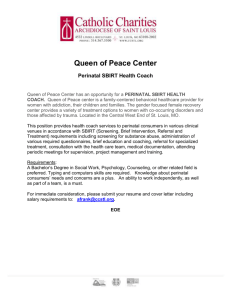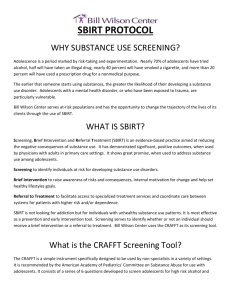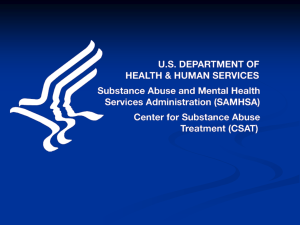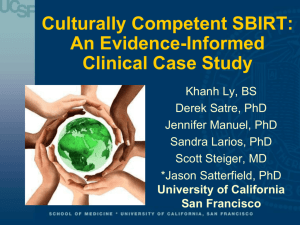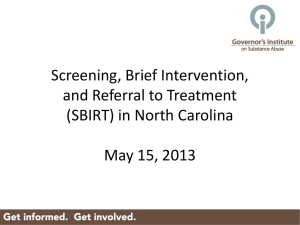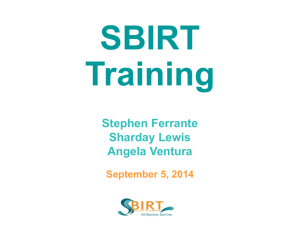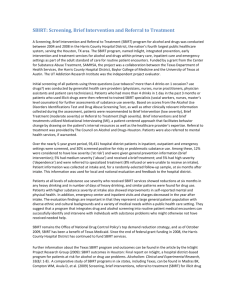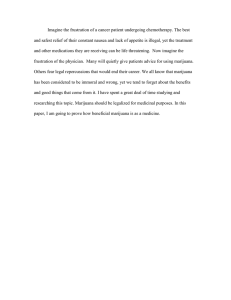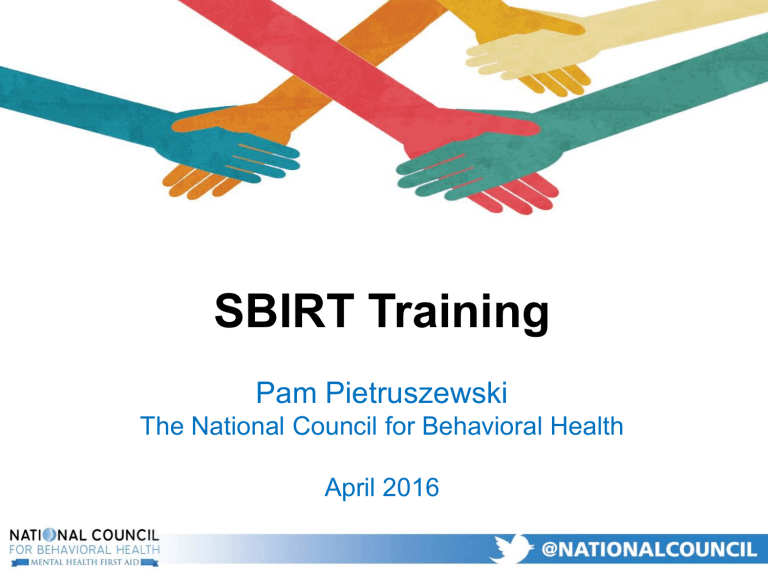
SBIRT Training Pam Pietruszewski The National Council for Behavioral Health April 2016 What is SBIRT? • Screening to identify patients at-risk for developing substance use disorders. • Brief Intervention to raise awareness of risks, elicit internal motivation for change, and help set healthy goals. • Referral to Treatment to facilitate access to specialized services and coordinate care between systems for patients with highest risk. 2 Recommended by the American Academy of Pediatrics • Regards substance abuse as a pediatric disorder • First published a policy statement in 2011 • Published a paper in July 2016 updating its statement • Advocates the use of SBIRT in the varied settings in which youth receive healthcare. SBIRT Paradigm Shift • Not looking for addiction • Looking for individuals with unhealthy substance use patterns • Looking for opportunities for intervention • Meeting people where they are 4 Video: Anti-SBIRT Video: Effective SBIRT SBIRT Work Flow Screening No Use Low Risk Reinforce healthy choices CRAFFT Score 1 or > Moderate Risk High Risk Brief Intervention 1-4 sessions Brief Intervention AND Referral to Treatment Follow-up Screening A systematic way of identifying potential for problems using a standardized, reliable and valid tool 8 Brief Screen (Pre-Screen) During the past 12 months, did you: 1. Drink any alcohol (more than a few sips)? 2. Smoke any marijuana or hashish? 3. Use anything else to get high? If any “YES” ask full CRAFFT questions If all “NO” just ask CAR question 9 “Healthy Lifestyle” Screening Another Brief Screen (S2BI) In the past year how many times have you used… 1. 2. 3. 4. 5. 6. 7. 8. Tobacco products (including e-cigarettes or vaping) Alcohol Marijuana Illegal drugs (such as cocaine or Ecstasy) Prescription drugs not prescribed for you (such as pain medication or Adderall) OTC medications (such as cough medicine) for non-medical reasons Inhalants (such as nitrous oxide) Herbs or synthetic drugs (such as salvia, K2 or bath salts) If any “YES” ask full CRAFFT questions If all “NO” just ask CAR question No history of use History past year use History monthly use History daily use No Risk Severe Risk Mild Risk Moderate Risk Levy et al. JAMA Pediatr. 2014 Full Screen: CRAFFT 1. Have you ever ridden in a car driven by someone (including yourself) who was “high” or had been using alcohol or drugs? 2. Do you ever use alcohol or drugs to relax, feel better about yourself, or fit in? 3. Do you ever use alcohol or drugs while you are by yourself, or alone? 4. Do you ever forget things you did while using alcohol or drugs? 5. Do your family or friends ever tell you that you should cut down on your drinking or drug use? 6. Have you ever gotten into trouble while you were using alcohol or drugs? 12 CRAFFT Scoring Low Risk Moderate Risk High Risk Abstinence CRAFFT Score 1 CRAFFT Score 2+ If 1+ provide brief intervention If 2+ also consider referral to treatment. Source: American Academy of Pediatrics, 2011 CRAFFT IS IN AWARDS Screening is an Ongoing Process ATTC Adolescent SBIRT Learner's Guide Optional: • Alcohol is the most commonly used drug among youth in the United States. Excessive drinking is responsible for more than 4,300 deaths among underage youth each year and cost the U.S. $24 billion annually. In addition to the thousands of deaths each year that result from underage drinking, approximately 200,000 young people visit an emergency room for alcohol related injuries. Despite these staggering numbers, 2015 marked the lowest levels for alcohol use recorded by government data among high school youth. This strongly contradicts the common refrains often heard that “all teenagers drink,” or “it is a harmless rite of passage.” National Institute on Alcohol Abuse and Alcoholism. Alcohol Screening and Brief Intervention for Youth; A Practitioner's Guide. Rockville, MD: National Institute on Alcohol Abuse and Alcoholism;2011. Brief Intervention 15-30 minutes Help clients to be aware of their patterns of use, understand the associated risks and make their own decisions. Help patients to accept more intensive treatment for those who might benefit. http://www.integration.samhsa.gov/clinical-practice/sbirt/brief-interventions 22 Brief Intervention The Brief Negotiated Interview Format 1. 2. 3. 4. Raise the subject Provide feedback Enhance motivation Develop a plan Brief Intervention 1. 2. 3. 4. Raise the subject Provide feedback Enhance motivation Develop a plan National Survey on Drug Use and Health, SAMHSA https://www.healthypeople.gov https://www.healthypeople.gov THC is at a historic high (paranoia, hallucinations, anxiety) < 4% in 1995 12% in 2014 Disapproval is at historic low 32% (lowest since 1975) Addressing Marijuana Myths SBIRT Colorado: www.healthteamworks.org Marijuana is all natural Marijuana may also contain harmful contaminants. Many natural substances are known to harm human health. Marijuana helps with stress and anxiety It is important to identify underlying causes of stress and anxiety. Explore alternatives to marijuana. Heavier users of marijuana may experience improved mental clarity and motivation when they stop using. It’s legal. So why quit, or how could it be a problem? Other legal substances such as tobacco, alcohol, and prescription narcotics cause significant harm. Marijuana is associated with serious, long-term negative health effects. MI Sandwich Approach to Feedback Elicit: What do you know about… Advise: That’s partially correct…in addition… Elicit: What do you think? Where does that leave you? Brief Intervention 1. 2. 3. 4. Raise the subject Provide feedback Enhance motivation Develop a plan Motivational interviewing is a collaborative, person-centered, guiding method designed to elicit and strengthen motivation for change. Miller & Rollnick, 2012 MI Spirit Partnership Evocation Acceptance Compassion Motivational Interviewing for Adolescent Substance Use: A Review of the Literature Barnett, et al. Addict Behav 2012 “MI appears to be a good fit with adolescents’ developmental need to exert their independence and make decisions for themselves, while it respects their heightened levels of psychological reactance and coincides with the development of their decision-making skills.” Some Motivational Interviewing Principles 1. Motivation is not static. 2. Ambivalence is normal to the change process. 3. Pushing too hard will evoke resistance to change. 4. Evoking patient’s own change talk will enhance behavior change. Ambivalence Change Talk Sustain Talk Developing Discrepancy “What are the good things about pot? “What are the not so good things about pot?” Pros Cons Decisional Balance Good Not so good No change 1 2 Change 4 3 Listening to Motivate Change • • • • Open-Ended Inquiry Affirmations Reflections Summarize Open-Ended Inquiry Instead of: Try: Do you get any exercise? What activities do you enjoy? Can you cut back? How have you approached changes in the past? Attributes of Successful Changers Accepting Adaptable Alert Ambitious Assertive Brave Careful Committed Considerate Creative Determined Eager Faithful Flexible Focused Forgiving Hopeful Ingenious Mature Open Patient Persistent Reasonable Reliable Steady Strong Thorough Trusting Truthful Willing Reflections • What you hear, what you observe • Not problem solving or advice • Succinct ~ momentum 41 “I like to chill with my friends. I’m not going to quit smoking pot because it’s not a problem.” You don’t want to quit smoking pot. Hanging out with your friends is an opportunity to relax. Pot doesn’t pose any problems for you and if it did you would do something about it. Being Prepared for “Resistance” 1. Everyone drinks. 2. Pot is no big deal. 3. I can quit anytime I want to. 4. There’s nothing else to do around here. Open-Ended Inquiry Affirmations Reflections What are we especially listening for? The person’s own arguments for change! Desire Ability Reasons Need Commitment Action Taking steps Nothing works I can’t miss any more school I’m a loser I’ve heard it all before I need to get my phone back Change Talk The Road to Change • What would need to happen for you to want to make a change? (Desire) • How would you do it if you decided? (Ability) • What are the three best reasons? (Reason) • What’s most important to you? (Need) Brief Intervention 1. 2. 3. 4. Raise the subject Provide feedback Enhance motivation Develop a plan Achievable Goals Defining Success Risky behaviors & associated consequences vs Quantity & frequency • What could you do differently? • What might be your next step? • What would a shift in use look like? Readiness Rulers – On a scale of 0 to 10, how important is it for you to do something different? – On a scale of 0 to 10, how confident are you that you can do something different? Close on Good Terms Summarize the patient’s statements in favor of change. Emphasize the patient’s strengths. What agreement was reached? CDC, 2014 Video: Adolescent Referral to Treatment Use the BI Structure (even if referring to treatment) especially if referring to treatment 1. 2. 3. 4. Raise the subject Provide feedback Enhance motivation Develop a plan Help clients trust the process By being part of the process “Steven over at the treatment center is really good at…” “I’d like to touch base to see how you’re doing…” RT at Bill Wilson Center 1. Refer to the systems of care for clients more open to entering treatment or who have parent/guardian who will ensure participation. 2. Obtain a release of information from client in order to follow up and connect with the intake person and later the substance use treatment provider, so that there can be on-going communication. Youth System of Care (YSOC) Adult System of Care (ASOC) “Gateway” 408 272-6518 1-800-488-9919 https://www.sccgov.org/sites/ dads/Youth-System-ofCare/Pages/home.aspx https://www.sccgov.org/sites/dads /Adult%20System%20of%20Care/ Pages/Adult-System-of-Care.aspx • Networks of providers overseen by our county’s Department of Behavioral Health Services. • Each have a single entry point. • Once a referral is received, it is screened to match the client to a provider, based on geographic location and language or cultural considerations. Other RT Options Seven Challenges • Evidence-based, harm-reduction model that focusses on decision making. • We have both groups and individual sessions available. • Particularly suitable for youth in a pre-contemplative stage of change. Other Resources • Stephen Betts, Director, Behavior Health Integration 408 850-6137 sbetts@billwilsoncenter.org Resources RASAI Program Resources http://www.nationalcouncildocs.net/reducing-adolescent-substanceabuse-initiative Alcohol Screening and Brief Intervention for Youth: A Practitioner's Guide http://www.niaaa.nih.gov/Publications/EducationTrainingMaterials/Pa ges/YouthGuide.aspx Adolescent SBIRT Curriculum – NORC Univ of Chicago & Kognito http://sbirt.webs.com/curriculum Thank You! pamp@thenationalcouncil.org
